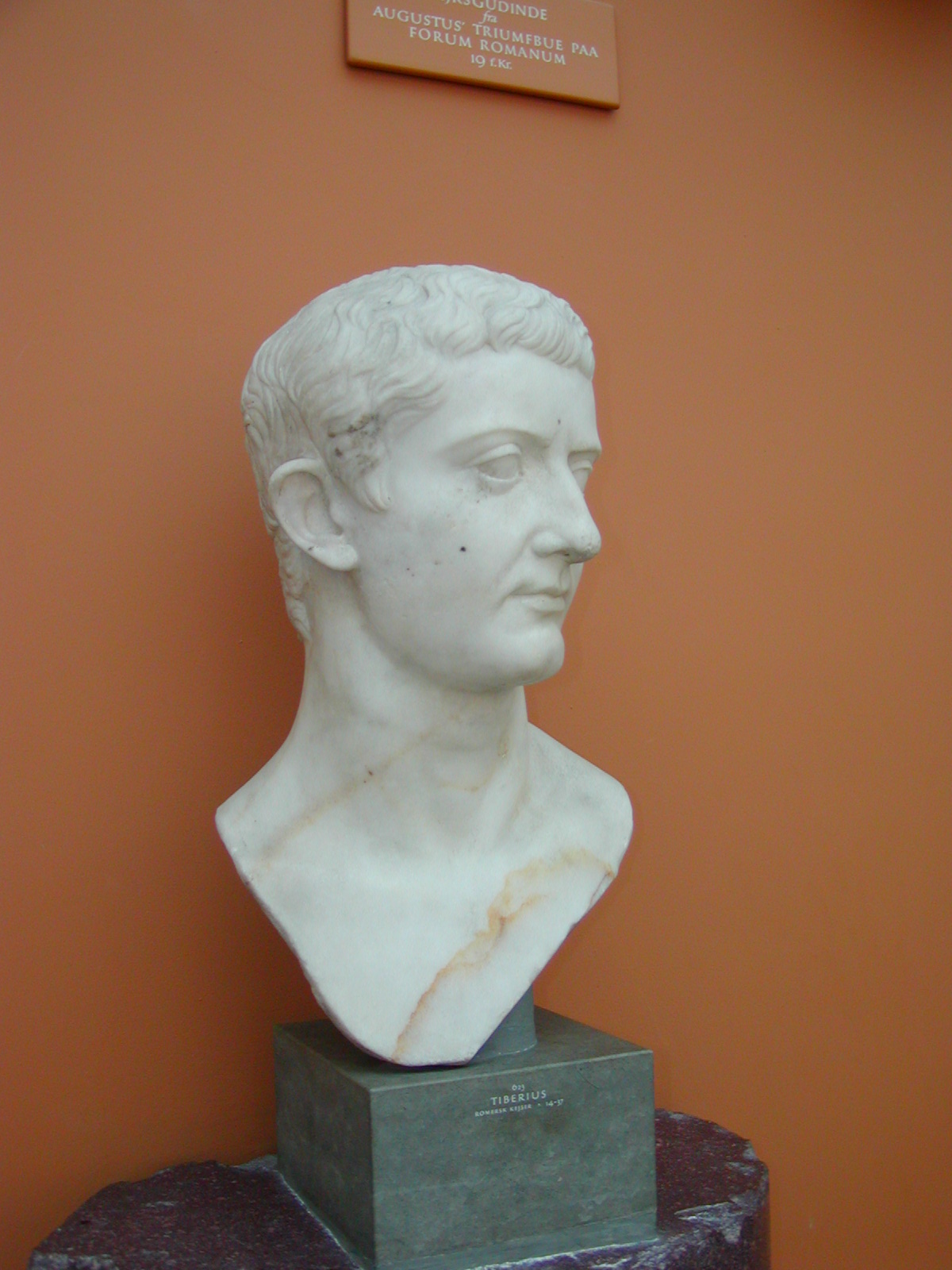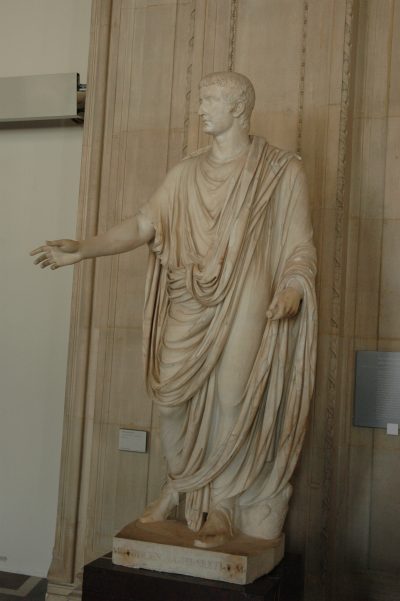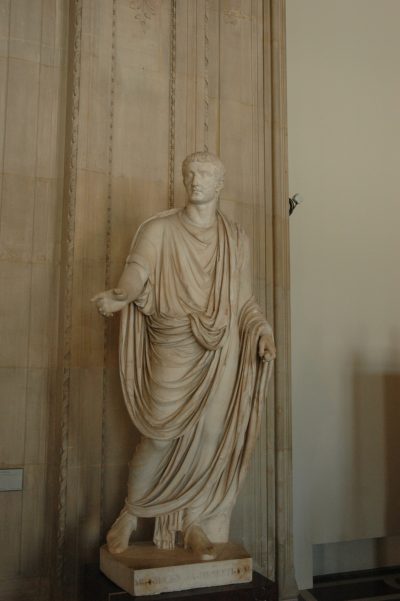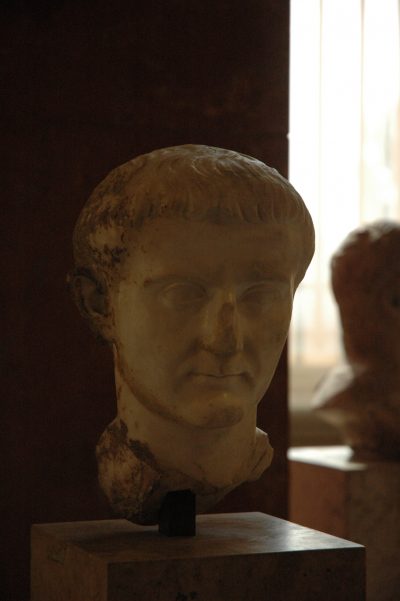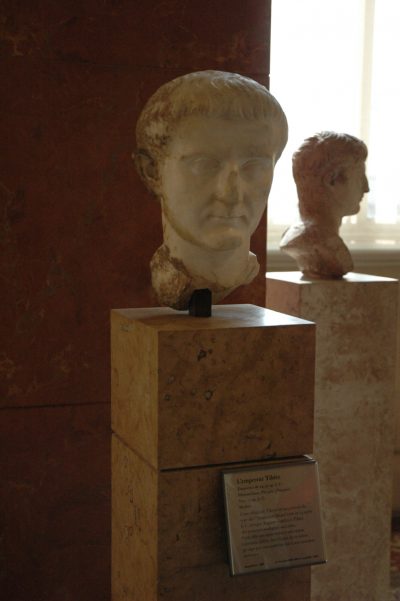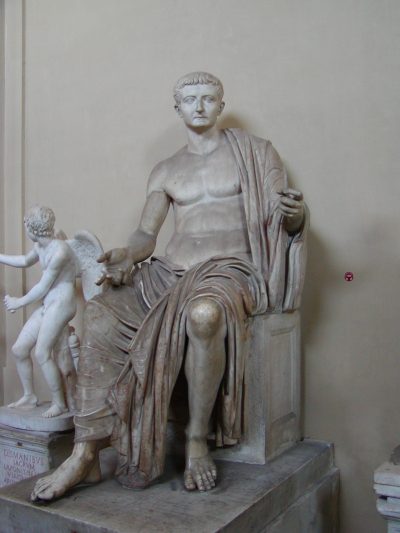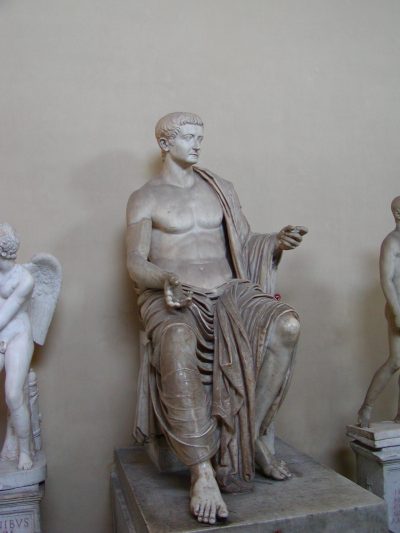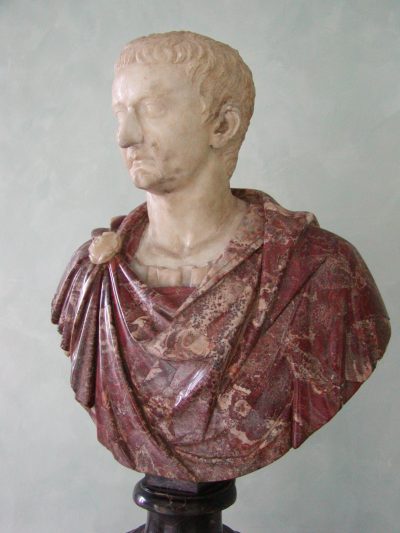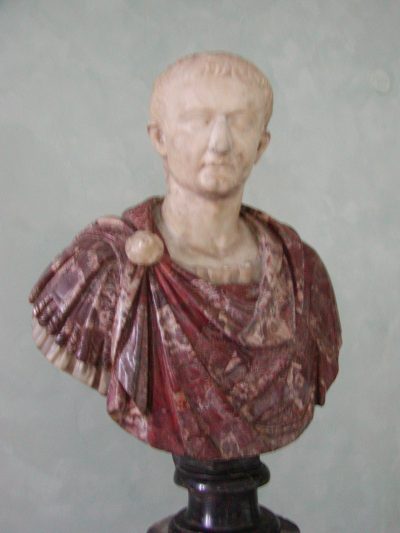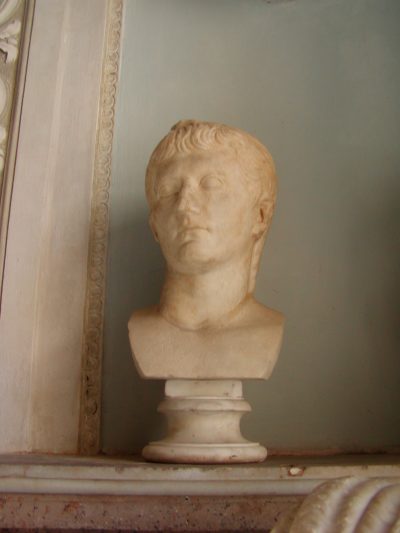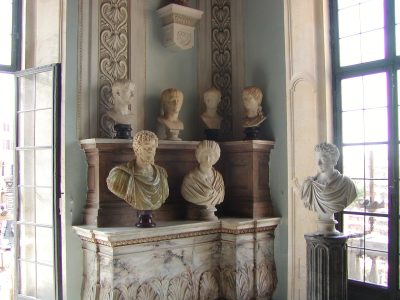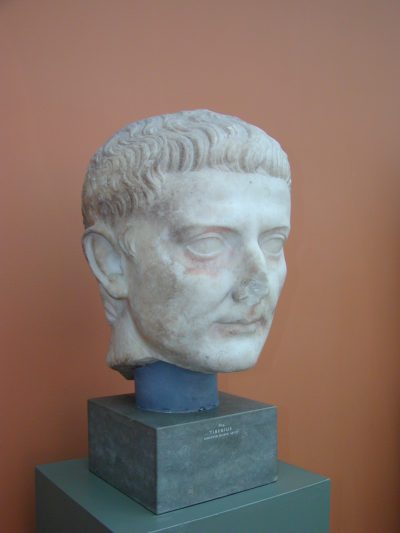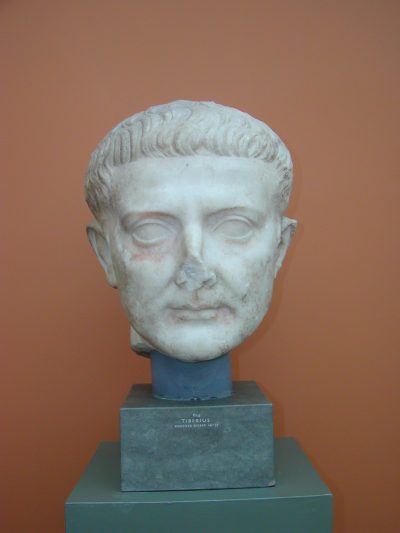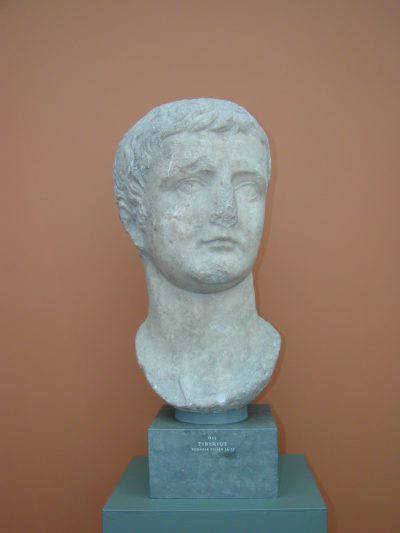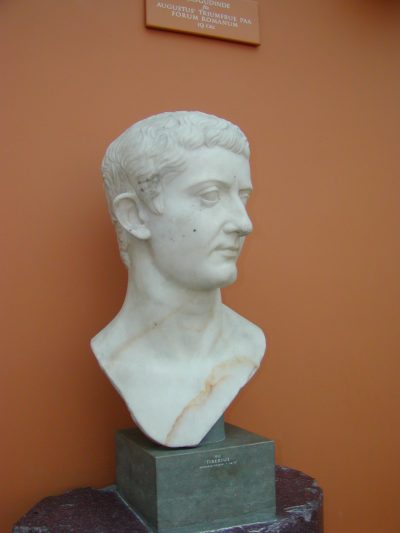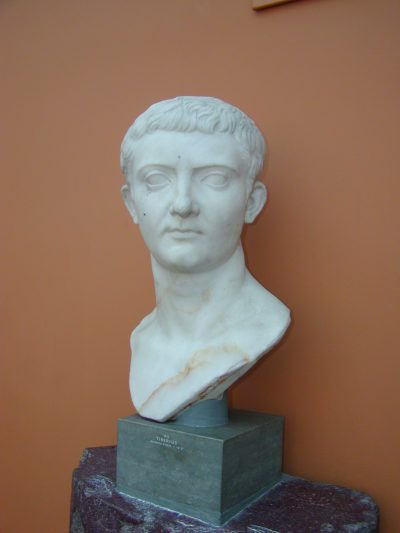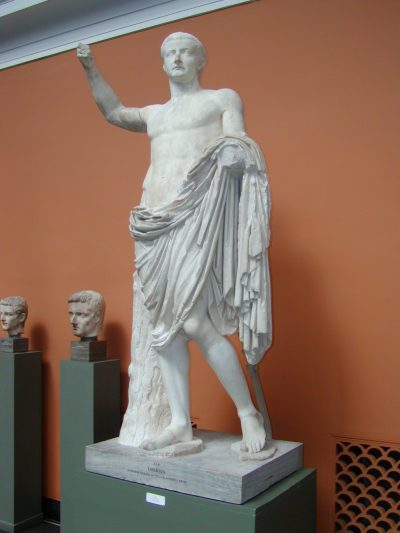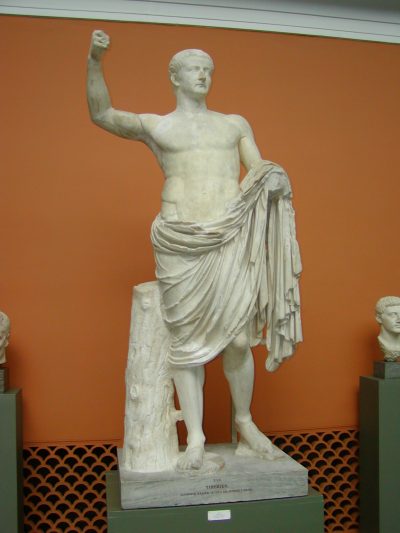Tiberius Claudius Nero (42 BCE – 37 CE) was the son of Tiberius Claudius Nero and Livia Drusilla, both of the patrician family gens claudia. Tiberius became emperor in 14 CE after the death of Augustus.
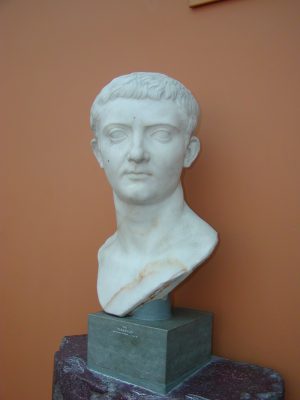
Initially Tiberius’ life and career was much as could be expected of a young man of wealthy patrician descent, except that he became Octavian’s stepson at the age of four when his mother Livia married Octavian in 38 BCE.
In 29 BCE he participated in Octavian‘s triumph after the battle of Actium, on Octavian’s chariot, in 27 BCE he put on the adult mans toga virilis and was introduced on the Forum by Augustus, and in 24 BCE at the age of 17 he was quaestor and was allowed to stand for the praetorship and consulship five years early.
Tiberius also held military command, and in 20 BCE he oversaw the victory over the Parthians that brought back the lost standards from previous wars. Following this success he was granted praetorian rank. After that he was governor of Gallia Comata for a year and around the same time he married Agrippa‘s daughter Vipsania.
In 13 BCE Tiberius was consul for the first time.
Before 12 BCE Tiberius had only a marginal role in Augustus‘ dynastic plans, but after the death of Agrippa, Augustus found himself without an adult and accomplished successor.
The direct descendants of Augustus were all too young, so he turned to his stepson Tiberius. Augustus used marriage to his only daughter Julia to forge close family ties with his designated heirs, so he forced Tiberius to divorce Vipsania and marry Julia.
Tiberius marriage to Vipsania had been very happy. He was unable to hide his feelings towards her, and when he saw her in public after the divorce, he stared at her so affectionately that it was noted, and Augustus ordered that Vipsania was not to be allowed near him.
In the following years Tiberius had several military commissions assigned to him, and he performed well. In 7 BCE he was consul for a second time, and the year after he was granted tribunician power for five years and sent to the East. Tiberius’ chances of succeeding Augustus were as good as ever.
Then, in 6 BCE, he suddenly and without warning retired from public life and went to Rhodes with a small retinue. His reasons for doing so are unknown, but it threw Augustus into a fury.
Once again he was without an heir and the principate was in jeopardy, should anything happen to Augustus. Tiberius was probably protected from the ire of Augustus by his mother Livia.
Amongst the reasons conjectured were the constant adultery of Julia that brought shame on Tiberius’ head, and his fear that Augustus would prefer Gaius and Lucius Caesar to him as soon as they came of age.
Tiberius’ tribunician powers were not renewed in 1 BCE indicating his fall from grace, but in 2 CE matters again turned in his favour.
The group of possible heirs to Augustus was diminishing. Drusus, his brother, had died in 9 BCE, and Lucius Caesar in 2 CE, leaving only Gaius Caesar and Tiberius. After the death of Lucius Caesar Tiberius was allowed to return to Rome, but he lived in a kind of political limbo.
Then in 4 CE Gaius Caesar died of a battle wound in Armenia. Augustus was heart broken by the loss of his two adoptive sons, but was force to reinstate Tiberius as heir designate.
Augustus adopted Tiberius, but forced Tiberius to adopt his own nephew Germanicus, even though Tiberius had a natural son named Drusus. Germanicus was married to Agrippina the Elder, Augustus’ grand-daughter, hence the offspring of Germanicus would be direct descendents of Augustus.
After his adoption in 4 CE Tiberius was granted tribunician (legislative) power and proconsular (military) power, and in 13 CE his powers were made equal to Augustus’, effectively making him ruling co-emperor. When Augustus died in 14 CE, the question of succession was a non-issue. Tiberius already had the powers of emperor.
The succession had to be confirmed by the senate, but the ceremony went wrong. Tiberius was unclear about his plans and expectations, and the senate was confused and uncertain about how to handle the situation.
Tiberius was so reluctant to take the full responsibility of being princeps that the senate perceived it as a refusal. In the end Tiberius accepted all titles and honours, except the title Augustus.
The relationship between Tiberius and the senate would never be good, though, and Tiberius treated the council with little respect.
The armies stationed on the German and Pannonian fronts used the situation around the death of Augustus to rebel in protest against the conditions of service. The armies were under the command of Tiberius’ sons Germanicus and Drusus, and they had a hard time bringing the troops under control.
Germanicus had much military success in Germany, and in 18 CE he was granted tribunician power and sent to the East, where he died the year after under mysterius circumstances. Germanicus had said on his deathbed that he had been poisoned by Piso, the governor of Syria, who had been appointed by Tiberius, thus putting suspicion on Tiberius himself.
Agrippina the Elder returned to Rome and continued to accuse Piso of her husbands death. Piso was tried in front of the senate, received no support from Tiberius and committed suicide.
Tiberius now elevated Drusus to his heir, but Agrippina continued to complain and cause trouble.
The following years were dominated by the intrigues of Sejanus. L. Aelius Sejanus had been prefect of the Praetorian Guard, the only military force allowed inside the city of Rome, since 15 CE. Sejanus had managed to seduce Livilla, Tiberius’ niece and wife of Drusus, and in 23 CE the two of them managed to poison and kill Drusus without causing suspicion. They Sejanus initiated a series of charges of treason against Agrippina and her children, and in a short time Agrippina and her two sons were convicted and imprisoned.
Tiberius trusted Sejanus, and Sejanus used his position to try to become Tiberius’ heir, much as Agrippa had become heir designate of Augustus. Consequently, in 25 CE, Sejanus asked Tiberius for permission to marry Livilla, but Tiberius refused the request, hindering Sejanus’ plans. Sejanus got a second chance, however, when Tiberius retired to Capri the next year, never to return to Rome. This gave Sejanus an almost free hand in Rome.
Tiberius started to give in to Sejanus wishes, and in 30 CE Sejanus was betrothed to Livillas daughter. The year after he and Tiberius jointly held the consulship, an honour normally reserved for heirs to the throne, and after that he was granted a part of Tiberius’ proconsular power. Sejanus was summoned to the senate, where he expected to receive tribunician power, but in a long letter from Tiberius his plans were denounced. The supporters of Sejanus fled the senate and the praetorian guard, that had been placed under a new command in secret, started a purge of Sejanus, his family and all his supporters. Livilla also died. The purges continued for some time, the last killings taking place in 33 CE.
After the Sejanus affair Tiberius became ever more recluse, ruling by letter. Apparently depressed, he made no provisions for succession, and when he died in 37 CE there were only two candidates: Gaius, son of Germanicus and nicknamed Caligula (little boots), and Tiberius Gemellus, son of Livilla and Drusus, hence grand-son of Tiberius.
Tiberius was very unpopular with both the upper and lower classes, and after his death the senate refused to deify him. It is said that the mob roamed the streets crying “Tiberius to the Tiber” (the corpses of executed criminals and dead gladiators were normally dumped in the Tiber).
When Tiberius’ will was read to the senate, he appointed Gaius and Tiberius Gemellus joint emperors. Gaius with the support of Macro, the prefect of the praetorian guard, had Tiberius’ will nullified to become sole emperor. He then adopted Tiberius Gemellus and appointed him junior princeps, but within a year Tiberius Gemellus was murdered.
Links
- http://www.roman-emperors.org/tiberius.htm
Photo gallery for "Tiberius"
There are 17 photos in this gallery.

